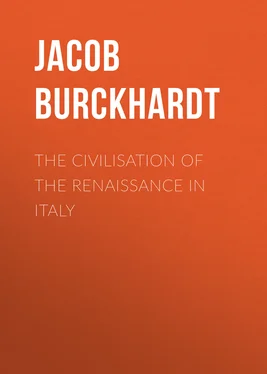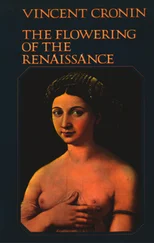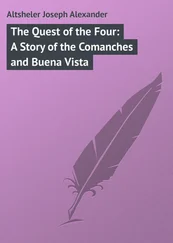Jacob Burckhardt - The Civilisation of the Renaissance in Italy
Здесь есть возможность читать онлайн «Jacob Burckhardt - The Civilisation of the Renaissance in Italy» — ознакомительный отрывок электронной книги совершенно бесплатно, а после прочтения отрывка купить полную версию. В некоторых случаях можно слушать аудио, скачать через торрент в формате fb2 и присутствует краткое содержание. Жанр: foreign_prose, История, foreign_edu, foreign_antique, на английском языке. Описание произведения, (предисловие) а так же отзывы посетителей доступны на портале библиотеки ЛибКат.
- Название:The Civilisation of the Renaissance in Italy
- Автор:
- Жанр:
- Год:неизвестен
- ISBN:нет данных
- Рейтинг книги:5 / 5. Голосов: 1
-
Избранное:Добавить в избранное
- Отзывы:
-
Ваша оценка:
- 100
- 1
- 2
- 3
- 4
- 5
The Civilisation of the Renaissance in Italy: краткое содержание, описание и аннотация
Предлагаем к чтению аннотацию, описание, краткое содержание или предисловие (зависит от того, что написал сам автор книги «The Civilisation of the Renaissance in Italy»). Если вы не нашли необходимую информацию о книге — напишите в комментариях, мы постараемся отыскать её.
The Civilisation of the Renaissance in Italy — читать онлайн ознакомительный отрывок
Ниже представлен текст книги, разбитый по страницам. Система сохранения места последней прочитанной страницы, позволяет с удобством читать онлайн бесплатно книгу «The Civilisation of the Renaissance in Italy», без необходимости каждый раз заново искать на чём Вы остановились. Поставьте закладку, и сможете в любой момент перейти на страницу, на которой закончили чтение.
Интервал:
Закладка:
This double current of feeling is also recognisable in the ‘Dittamondo’ of Fazio degli Uberti, composed about the year 1360—a description of visionary travels, in which the author is accompanied by the old geographer Solinus, as Dante was by Virgil. They visit Bari in memory of St. Nicholas, and Monte Gargano of the archangel Michael, and in Rome the legends of Araceli and of Santa Maria in Trastevere are mentioned. Still, the pagan splendour of ancient Rome unmistakably exercises a greater charm upon them. A venerable matron in torn garments—Rome herself is meant—tells them of the glorious past, and gives them a minute description of the old triumphs; 409she then leads the strangers through the city, and points out to them the seven hills and many of the chief ruins—‘che comprender potrai, quanto fui bella.’
Unfortunately this Rome of the schismatic and Avignonese popes was no longer, in respect of classical remains, what it had been some generations earlier. The destruction of 140 fortified houses of the Roman nobles by the senator Brancaleone in 1257 must have wholly altered the character of the most important buildings then standing; for the nobles had no doubt ensconced themselves in the loftiest and best-preserved of the ruins. 410Nevertheless, far more was left than we now find, and probably many of the remains had still their marble incrustation, their pillared entrances, and their other ornaments, where we now see nothing but the skeleton of brickwork. In this state of things, the first beginnings of a topographical study of the old city were made.
In Poggio’s walks through Rome 411the study of the remains themselves is for the first time more intimately combined with that of the ancient authors and inscriptions—the latter he sought out from among all the vegetation in which they were imbedded 412—the writer’s imagination is severely restrained, and the memories of Christian Rome carefully excluded. The only pity is that Poggio’s work was not fuller and was not illustrated with sketches. Far more was left in his time than was found by Raphael eighty years later. He saw the tomb of Cæcilia Metella and the columns in front of one of the temples on the slope of the Capitol first in full preservation, and then afterwards half destroyed, owing to that unfortunate quality which marble possesses of being easily burnt into lime. A vast colonnade near the Minerva fell piecemeal a victim to the same fate. A witness in the year 1443 tells us that this manufacture of lime still went on; ‘which is a shame, for the new buildings are pitiful, and the beauty of Rome is in its ruins.’ 413The inhabitants of that day, in their peasants’ cloaks and boots, looked to foreigners like cowherds; and in fact the cattle were pastured in the city up to the Banchi. The only opportunities for social gatherings were the services at church, on which occasion it was possible to get a sight of the beautiful women.
In the last years of Eugenius IV. (d. 1447) Blondus of Forli wrote his ‘Roma Instaurata,’ making use of Frontinus and of the old ‘Libri Regionali,’ as well as, it seems, of Anastasius. His object is not only the description of what existed, but still more the recovery of what was lost. In accordance with the dedication to the Pope, he consoles himself for the general ruin by the thought of the precious relics of the saints in which Rome was so rich. 414
With Nicholas V. (1447-1455) that new monumental spirit which was distinctive of the age of the Renaissance appeared on the papal throne. The new passion for embellishing the city brought with it on the one hand a fresh danger for the ruins, on the other a respect for them, as forming one of Rome’s claims to distinction. Pius II. was wholly possessed by antiquarian enthusiasm, and if he speaks little of the antiquities of Rome, 415he closely studied those of all other parts of Italy, and was the first to know and describe accurately the remains which abounded in the districts for miles around the capital. 416It is true that, both as priest and cosmographer, he is interested alike in classical and Christian monuments and in the marvels of nature. Or was he doing violence to himself when he wrote that Nola was more highly honoured by the memory of St. Paulinus than by all its classical reminiscences and by the heroic struggle of Marcellus? Not, indeed, that his faith in relics was assumed; but his mind was evidently rather disposed to an inquiring interest in nature and antiquity, to a zeal for monumental works, to a keen and delicate observation of human life. In the last years of his Papacy, afflicted with the gout and yet in the most cheerful mood, he was borne in his litter over hill and dale to Tusculum, Alba, Tibur, Ostia, Falerii, and Ocriculum, and whatever he saw he noted down. He followed the line of the Roman roads and aqueducts, and tried to fix the boundaries of the old tribes who dwelt round the city. On an excursion to Tivoli with the great Federigo of Urbino the time was happily spent in talk on the military system of the ancients, and particularly on the Trojan war. Even on his journey to the Congress of Mantua (1459) he searched, though unsuccessfully, for the labyrinth of Clusium mentioned by Pliny, and visited the so-called villa of Virgil on the Mincio. That such a Pope should demand a classical Latin style from his abbreviators, is no more than might be expected. It was he who, in the war with Naples, granted an amnesty to the men of Arpinum, as countrymen of Cicero and Marius, after whom many of them were named. It was to him alone, as both judge and patron, that Blondus could dedicate his ‘Roma Triumphans,’ the first great attempt at a complete exposition of Roman antiquity. 417
Nor was the enthusiasm for the classical past of Italy confined at this period to the capital. Boccaccio 418had already called the vast ruins of Baiæ ‘old walls, yet new for modern spirits;’ and since this time they were held to be the most interesting sight near Naples. Collections of antiquities of all sorts now became common. Ciriaco of Ancona (d. 1457), who explained (1433) the Roman monuments to the Emperor Sigismund, travelled, not only through Italy, but through other countries of the old world, Hellas, and the islands of the Archipelago, and even parts of Asia and Africa, and brought back with him countless inscriptions and sketches. When asked why he took all this trouble, he replied, ‘To wake the dead.’ 419The histories of the various cities of Italy had from the earliest times laid claim to some true or imagined connection with Rome, had alleged some settlement or colonisation which started from the capital; 420and the obliging manufacturers of pedigrees seem constantly to have derived various families from the oldest and most famous blood of Rome. So highly was the distinction valued, that men clung to it even in the light of the dawning criticism of the fifteenth century. When Pius II. was at Viterbo 421he said frankly to the Roman deputies who begged him to return, ‘Rome is as much at home as Siena, for my House, the Piccolomini, came in early times from the capital to Siena, as is proved by the constant use of the names Æneas and Sylvius in my family.’ He would probably have had no objection to be held a descendant of the Julii. Paul II., a Barbo of Venice, found his vanity flattered by deducing his House, notwithstanding an adverse pedigree, according to which it came from Germany, from the Roman Ahenobarbus, who led a colony to Parma, and whose successors were driven by party conflicts to migrate to Venice. 422That the Massimi claimed descent from Q. Fabius Maximus, and the Cornaro from the Cornelii, cannot surprise us. On the other hand, it is a strikingly exceptional fact for the sixteenth century that the novellist Bandello tried to connect his blood with a noble family of Ostrogoths (i. nov. 23).
To return to Rome. The inhabitants, ‘who then called themselves Romans,’ accepted greedily the homage which was offered them by the rest of Italy. Under Paul II., Sixtus IV., and Alexander VI. magnificent processions formed part of the Carnival, representing the scene most attractive to the imagination of the time—the triumph of the Roman Imperator. The sentiment of the people expressed itself naturally in this shape and others like it. In this mood of public feeling, a report arose, that on April 15, 1485, the corpse of a young Roman lady of the classical period—wonderfully beautiful and in perfect preservation—had been discovered. 423Some Lombard masons digging out an ancient tomb on an estate of the convent of Santa Maria Novella, on the Appian Way beyond the Cæcilia Metella, were said to have found a marble sarcophagus with the inscription, ‘Julia, daughter of Claudius.’ On this basis the following story was built. The Lombards disappeared with the jewels and treasure which were found with the corpse in the sarcophagus. The body had been coated with an antiseptic essence, and was as fresh and flexible as that of a girl of fifteen the hour after death. It was said that she still kept the colours of life, with eyes and mouth half open. She was taken to the palace of the ‘Conservatori’ on the Capitol; and then a pilgrimage to see her began. Among the crowd were many who came to paint her; ‘for she was more beautiful than can be said or written, and, were it said or written, it would not be believed by those who had not seen her.’ By the order of Innocent VIII. she was secretly buried one night outside the Pincian Gate; the empty sarcophagus remained in the court of the ‘Conservatori.’ Probably a coloured mask of wax or some other material was modelled in the classical style on the face of the corpse, with which the gilded hair of which we read would harmonise admirably. The touching point in the story is not the fact itself, but the firm belief that an ancient body, which was now thought to be at last really before men’s eyes, must of necessity be far more beautiful than anything of modern date.
Читать дальшеИнтервал:
Закладка:
Похожие книги на «The Civilisation of the Renaissance in Italy»
Представляем Вашему вниманию похожие книги на «The Civilisation of the Renaissance in Italy» списком для выбора. Мы отобрали схожую по названию и смыслу литературу в надежде предоставить читателям больше вариантов отыскать новые, интересные, ещё непрочитанные произведения.
Обсуждение, отзывы о книге «The Civilisation of the Renaissance in Italy» и просто собственные мнения читателей. Оставьте ваши комментарии, напишите, что Вы думаете о произведении, его смысле или главных героях. Укажите что конкретно понравилось, а что нет, и почему Вы так считаете.












